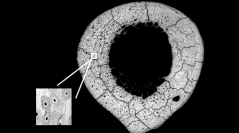

 Comptes Rendus Palevol
15 (1-2) - Pages 32-39
Comptes Rendus Palevol
15 (1-2) - Pages 32-39The aim of our research is to document osteocyte lacuna density (OCD) and its biological significance among humans of known life history. Twelve human midshaft femurs obtained from sub-Saharan Africans (Malawi) of Bantu origin and known life history were prepared for backscattered electron microscopy in the scanning electron microscope (BSE-SEM). Lacunae have a characteristic size and aspect ratio in BSE-SEM images that allowed them to be identified and automatically enumerated relative to the detected bone area in all of the images processed; values for adult whole femoral midshaft cross sections averaged about 100,000 osteocyte lacunae. Statistical tests reveal significant relationships between both OCD and osteocyte lacuna area with body height. It appears that the same increase in energetic efficiency observed in interspecific comparisons of the mass specific metabolic rate of bone at larger body sizes also characterizes body size categories among humans. Long period biological rhythms that regulate rates of cell proliferation explain some aspects of human body size variability.
Osteocyte lacunae density, Cell proliferation, Body size, Metabolism, Havers-Halberg Oscillation, Multidien rhythm